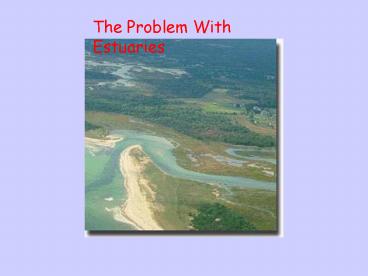Estuaries: Definition - PowerPoint PPT Presentation
1 / 16
Title:
Estuaries: Definition
Description:
Contain some of the most productive ecosystems on the planet ... advection: mass movement of sediment. Estuarine Deposition: Bottom. Postma model ... – PowerPoint PPT presentation
Number of Views:101
Avg rating:3.0/5.0
Title: Estuaries: Definition
1
The Problem With Estuaries
2
Why Are Estuaries So Important?
- Interface between land, ocean, and rivers
- Vital habitat for fish, shellfish, waterfowl
- Contain some of the most productive ecosystems on
the planet - Transportation routes and recreational
opportunities for humans - Some of the most densely populated coasts in the
world
3
Importance of Estuaries
Estuaries provide habitat for more than 75 of
America's commercial fish catch, and for 80-90
of the recreational fish catch (5).
Estuarine-dependent fisheries are among the most
valuable within regions and across the nation,
worth more than 1.9 billion in 1990, excluding
Alaska (4). Nationwide, commercial and
recreational fishing, boating, tourism, and other
coastal industries provide more than 28 million
jobs (2). Commercial shipping alone employed more
than 50,000 people as of January, 1997 (5). There
are 25,500 recreational facilities along the U.S.
coasts (5)- almost 44,000 square miles of outdoor
public recreation areas (4). The average American
spends 10 recreational days on the coast each
year. In 1993 more than 180 million Americans
visited ocean and bay beaches- nearly 70 of the
U.S. population. Coastal recreation and tourism
generate 8 to 12 billion annually (5) In just
one estuarine system- Massachusetts and Cape Cod
Bays- commercial and recreational fishing
generate about 240 million per year. In that
same estuary, tourism and beach-going generate
1.5 billion per year, and shipping and marinas
generate 1.86 billion per year (3).
4
Problems Facing Estuaries
- Nutrients have increased manyfold, causing
harmful algal blooms and depletion of oxygen
(hypoxia and anoxia) - Intertidal and tidal habitats have been filled
and dredged - Landscape alterations, water diversions, damming
of rivers - Changes to amounts and seasonal patterns of
freshwater and transported sediments sometimes
too much sediment - Overexploitation of natural resources (fisheries)
- Industrial pollution trace metals, PAHs, PCBs,
etc. - Invasive species and non-indigenous animals
habitat change and loss, displacement of native
species
5
(No Transcript)
6
(No Transcript)
7
(No Transcript)
8
(No Transcript)
9
Estuaries Definition
- Estuary where river meets the ocean, and
salinities vary from 35 ppt to lt5 ppt - -substantial river inflow and influence not
just a bay with a river flowing into it - -are protected waters, no long period swell
- Classic estuaries are drowned river valleys where
sediment inputs from the river and other sources
cannot keep pace with sea level rise
10
Estuarine Types Mixing
- Stratified where a large river dominates the
system, adding a greater volume of water than the
tide - -essentially where river discharge (Q) gtthe
tidal prism (TP) - Tidal Prism the height of the tide from MW to
HT - -salt wedge highly stratified where river water
overrides incoming saltwater, with the only
mixing occurring at the interface. Potomac River,
isohalines bend strongly at zone mixing - Isohalines lines of equal salinity
- Partially mixed considerable river inflow, but
tidal volume about the same. Q TP. Chesapeake
Bay
11
(No Transcript)
12
Estuary Types Mixing
- -isohalines bend gently upestuary, with not as
great a difference in salinity with depth between
surface and bottom - Fully Mixed volume of saltwater from tides
greater than river inflow. TPgtQ - -mixing by strong tidal currents and waves
- -in Bay of Fundytidal currents do the mixing
- -in Delaware Bay, currents and wave
- -isohalines run straight up and down
13
Estuary Types Tidal Height Changes
- Hypersynchronous bottom friction and shoreline
convergence causes a loss of tidal energy - -tide rises in amplitude, amplification, before
falling at the mouth of the river. Bay of Fundy - Synchronous essentially very little change in
tidal amplitude upestuary, or very slow decline. - -slow rise in the bottom, and gradual shoreline
convergence. Chesapeake Bay - Hyposynchronous very shrp decrease in amplitude
upestuary from high bottom friction and shoreline
convergence. Delaware Bay
14
Estuarine Deposition Surface
- Flocculation small clay particles bound together
by electrical attraction supplied by cations in
seawater (Ca, Mg, Na) - -generally occurs in mid-estuary,where neither
river currents or tidal currents produce much
turbulence - -varies in spatial position by seasonal river
flow - -advection mass movement of sediment
15
Estuarine Deposition Bottom
- Postma model
- -landward or seaward transport
- -bedload sand-size particles
- -ripples bigger and more widely spaced, the
stronger the currrent - -tidal flats often exposed, especially MLWS
- -contain burrowing organisms, like clams
16
Estuarine Water Quality Assessment
Physical Chemical Sampling Biological -Dissolve
d Oxygen -Water Quality -Salinity -Habitat
Quality -pH -Benthic Organisms -Turbidity -
Planktonic -Water Temperature -Intertidal
-Stream Discharge -Fecal Bacteria































